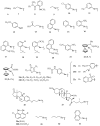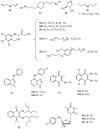Selenides and Diselenides: A Review of Their Anticancer and Chemopreventive Activity
- PMID: 29534447
- PMCID: PMC6017218
- DOI: 10.3390/molecules23030628
Selenides and Diselenides: A Review of Their Anticancer and Chemopreventive Activity
Abstract
Selenium and selenocompounds have attracted the attention and the efforts of scientists worldwide due to their promising potential applications in cancer prevention and/or treatment. Different organic selenocompounds, with diverse functional groups that contain selenium, have been reported to exhibit anticancer and/or chemopreventive activity. Among them, selenocyanates, selenoureas, selenoesters, selenium-containing heterocycles, selenium nanoparticles, selenides and diselenides have been considered in the search for efficiency in prevention and treatment of cancer and other related diseases. In this review, we focus our attention on the potential applications of selenides and diselenides in cancer prevention and treatment that have been reported so far. The around 80 selenides and diselenides selected herein as representative compounds include promising antioxidant, prooxidant, redox-modulating, chemopreventive, anticancer, cytotoxic and radioprotective compounds, among other activities. The aim of this work is to highlight the possibilities that these novel organic selenocompounds can offer in an effort to contribute to inspire medicinal chemists in their search of new promising derivatives.
Keywords: anticancer compounds; antioxidants; chemoprevention; cytostaticity; cytotoxicity; diselenides; selenides; selenium; selenocompounds.
Conflict of interest statement
The authors declare no conflict of interest.
Figures







Similar articles
-
Synthesis and biochemical studies of novel organic selenides with increased selectivity for hepatocellular carcinoma and breast adenocarcinoma.Eur J Med Chem. 2019 Oct 1;179:515-526. doi: 10.1016/j.ejmech.2019.06.075. Epub 2019 Jun 28. Eur J Med Chem. 2019. PMID: 31276896
-
Small molecule selenium-containing compounds: Recent development and therapeutic applications.Eur J Med Chem. 2021 Nov 5;223:113621. doi: 10.1016/j.ejmech.2021.113621. Epub 2021 Jun 12. Eur J Med Chem. 2021. PMID: 34217061 Review.
-
Recent Advances for the Synthesis of Selenium-containing Small Molecules as Potent Antitumor Agents.Curr Med Chem. 2018;25(17):2009-2033. doi: 10.2174/0929867325666171129220544. Curr Med Chem. 2018. PMID: 29189126 Review.
-
Selenium Compounds as Novel Potential Anticancer Agents.Int J Mol Sci. 2021 Jan 20;22(3):1009. doi: 10.3390/ijms22031009. Int J Mol Sci. 2021. PMID: 33498364 Free PMC article. Review.
-
Diselenides and Selenocyanates as Versatile Precursors for the Synthesis of Pharmaceutically Relevant Compounds.Curr Org Synth. 2022;19(3):317-330. doi: 10.2174/1570179418666210303113723. Curr Org Synth. 2022. PMID: 33655868 Review.
Cited by
-
Seleno-Warfare against Cancer: Decoding Antitumor Activity of Novel Acylselenoureas and Se-Acylisoselenoureas.Pharmaceutics. 2024 Feb 14;16(2):272. doi: 10.3390/pharmaceutics16020272. Pharmaceutics. 2024. PMID: 38399326 Free PMC article.
-
Does atmospheric dimethyldiselenide play a role in reducing COVID-19 mortality?Gondwana Res. 2023 Feb;114:87-92. doi: 10.1016/j.gr.2022.05.017. Epub 2022 Jun 6. Gondwana Res. 2023. PMID: 35692874 Free PMC article.
-
SLL-1A-16 suppresses proliferation and induces autophagy in non-small-cell lung cancer cells via the AKT/mTOR signaling pathway.RSC Med Chem. 2024 Aug 17;15(10):3460-8. doi: 10.1039/d4md00405a. Online ahead of print. RSC Med Chem. 2024. PMID: 39246748 Free PMC article.
-
Diphenyl Diselenide and SARS-CoV-2: in silico Exploration of the Mechanisms of Inhibition of Main Protease (Mpro) and Papain-like Protease (PLpro).J Chem Inf Model. 2023 Apr 10;63(7):2226-2239. doi: 10.1021/acs.jcim.3c00168. Epub 2023 Mar 23. J Chem Inf Model. 2023. PMID: 36952618 Free PMC article.
-
Novel N,N'-Disubstituted Acylselenoureas as Potential Antioxidant and Cytotoxic Agents.Antioxidants (Basel). 2020 Jan 8;9(1):55. doi: 10.3390/antiox9010055. Antioxidants (Basel). 2020. PMID: 31936213 Free PMC article.
References
Publication types
MeSH terms
Substances
LinkOut - more resources
Full Text Sources
Other Literature Sources

